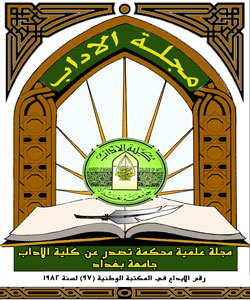صناعة السياحة المستدامة في المحيط بالمناطق التاريخية
DOI:
https://doi.org/10.31973/7tefyn02الكلمات المفتاحية:
المناطق التاريخية، السياحة، السياحة المستدامة، الاستدامة الحضرية، التراث الثقافيالملخص
صناعة السياحة في المناطق التاريخية تواجه العديد من التحديات التي تؤدي الى تدهور حالتها المادية وبالتالي تراجع قيمتها التاريخية وقد ترجع هذه التحديات الى الظروف البيئية والسكان المحللين واهمال السلطات لتلك المواقع وعدم استدامة المناطق المحيطة بالمواقع التاريخية استدامة حضرية وبالتالي زيادة السياحة مع بروز مفهوم السياحة المستدامة كأحد ابرز أنماط السياحة العالمية في الوقت الحالي لأسلوبها النقي والنظيف في الحفاظ على المواقع الطبيعية موازنه التراث وحماية البيئة الحضرية والحفاظ على هويتها وتسويقها بشكل مستدام للسياحة مما يعود بالنفع الى كافة الأطراف المشاركة في العملية السياحية المستدامة التي تسعى الى الاستثمار الأمثل للموارد الطبيعية والعمرانية والتغير من السياحة التقليدية الى السياحة الثقافية المستدامة وبالتالي ركزت المشكلة البحثية على تحديات متعددة تواجه المناطق التاريخية نتيجة التوسع العمراني وتغير استعمالات الأرض المحيطة بالمناطق التاريخية، مما قد يضر بالتراث الثقافي ويعرقل تعزيز صناعة السياحة المستدامة.
يهدف البحث بالتالي الى تعزيز السياحة المستدامة بأبعادها الفكرية والتطبيقية وتأثيرها على المناطق التاريخية من اجل النهوض بواقع هذه المناطق للوصول الى اعلى كفاءه ممكنة دعماً للتنمية المستدامة فيها على المدى الطويل بما يخص تطوراتها واثارها (الاجتماعية والاقتصادية والثقافية) على تلك المناطق التاريخية.
التنزيلات
المراجع
عبد، م.ح.، إحسان، س.، 2023. السياحة وأثرها على هجرة السكان الأصليين من مراكز المدن التاريخية) مركز المدينة القديمة في النجف كدراسة حالة (. في سلسلة مؤتمرات IOP: علوم الأرض والبيئة، 1129 ( 1)، ص 1-2:
عبد الباسط، و.، 2005. التنمية السياحية المستدامة بين الإستراتيجية والتحديات. مصر، حلوان: دار النهضة العربية للنشر والتوزيع، ص112.
عبد الحكيم، م.س، 2016. جغرافية السياحة. العلوم الإنسانية والاجتماعية – الجغرافيا والجيومورفولوجيا، الناشر – المكتبة الأنجلومصرية، ج1، ص168.
عبد الجبار، س.ن.، عبد الوهاب، أ.، 2023. دور الواقع المعزز في إبراز التراث التاريخي / قلعة كركوك، مجلة الهندسة، 29(12)، ص106-122.
عبد الإله، ع، الطائي، ح، 2004. التخطيط السياحي؛ المدخل الاستراتيجي، مؤسسة الوراق للنشر والتوزيع، عمان، الطبعة الأولى، ص77.
عبد المنعم، م.م، 2000. السياحة والتشريعات والمبادئ، عمان-الأردن: دار صفاء للنشر والتوزيع، ص19،
عبد الوهاب، ن. ن.، أسامة، س. إ.، ومحمد، ك.، 2001. استمرار التنمية السياحية في البلدان النامية (مع التطبيق على مصر). مصر: السياحة والفنادق، ص1-7، الطبعة الأولى.
الأحبابي، س.ح، 2014. بحث حول الحفاظ الحضري المستدام في المناطق التراثية، بغداد: مجلة كلية الهندسة، 17(2)، ص14- 25.
الأرناؤوطي، س. م.، 2001. بحث في السكن والثقافة وعلاقتهما بالمحيط التاريخي للمدينة. مؤتمر جنوب لبنان (التحدي الحضري في زمن التحرير)، جامعة بيروت العربية، بيروت – لبنان، ص9.
الدليمي،ع.م،2002. تطوير الخدمات والأنشطة السياحية في منطقة المدائن وأثرها في تنمية الطلب السياحي، رسالة ماجستير، كلية السياحة، الجامعة المستنصرية.
الحديثي، أ.ج، 2013. أسس جغرافية السياحة. ليبيا: جامعة عمر المختار، دار الكتاب الوطني للنشر والطباعة، ص186
الحياني، م.ن.، 2013. بحث في صناعة السياحة بين التكلفة والصحراء: دراسة ميدانية لتجربة دبي. مجلة ديالى للإنسان، 60 (1)، ص 5 – 46.
الجابري، ز.، شذى، أ.ه.، 2022. احياء المسار الثقافي ودوره في استدامة المناطق التاريخية – كربلاء أنموذجا. المجلة الدولية للتنمية المستدامة والتخطيط، 17(6)، ص 1737.
الجميلي، س.ك، 2008. السياحة الحيوية والعمارة. رسالة دكتوراه، جامعة بغداد، قسم الهندسة المعمارية، بغداد – العراق.
الخضراوي، ر.خ، 2012. الحفاظ على التراث العمراني لتحقيق تنمية سياحية مستدامة من خلال مؤسسات المجتمع المدني: دراسة حالة واحة سيوة، رسالة ماجستير، كلية التخطيط الإقليمي والعمراني، جامعة القاهرة، القاهرة – مصر..ص12 -45.
الكناني، أ. س.، سفيان، س. أ، وندى، ك.، 2021. التنمية السياحية للتراث في الجزائر: حالة موقع هيبون – عنابة. في سلسلة مؤتمرات IOP: علوم الأرض والبيئة، 754 (1):12006، ص 1.
النعيم، م.ب.، 2015. أفكار في السياحة والعمارة.” مقال منشور، جريدة الرياض، الرياض، المملكة العربية السعودية.، ص2.
الراوي، ع.، سالي، أ.ن، 2023. تجارب دولية في معنى السياحة البيئية للسياحة البيئية، مجلة التخطيط والتنمية، 28)2)، ص 50.
السلك، ج.م.، الشامي، ح.أ، 2015. إعادة تأهيل المباني الأثرية والتاريخية والتقليدية (استراتيجية المشروع التجريبي في إعادة تأهيل المباني التاريخية والتقليدية)، مجلة الهندسة، 21(3)، ص 1-23.
السلك، ج.م.، كوثر، ك.، 2021. الأوامر الخفية وأدوات الحفاظ على نسيج التراث، مجلة الهندسة المدنية والعمارة 9(2)، الصفحات من 439 إلى 452.
الشديدي، ح. ع، منير، ك.، 2017. إمكانات التنمية واستثمارها في منطقة دراسة التنمية السياحية، قضاء بلد. مجلة المخطط والتنمية،22(2)، ص112.
الشرقاوي، ف.م.، حنفي، لوس أنجلوس، 2008. الاتجاهات الحديثة في السياحة. مصر-الإسكندرية: دار المعرفة، الطبعة الأولى، ص18.
التميمي، أ.ع، هدى، ع.، 2019. السياحة المستدامة في أماكن التراث العمراني – القشلاق دراسة حالة، مجلة اتحاد الجامعات العربية للعلوم الهندسية، 26(2)، ص5.
التميمي، ر.س، 2008. العولمة والتنمية البشرية المستدامة في الوطن العربي. عمان: دار دجلة للنشر، ص 326-329.
المنظمة العربية للتنمية الإدارية، 2007. دليل السياحةالتنمية المستدامة في الوطن العربي. القاهرة، مصر: الطبعة الأولى.
بظاظا، ك.، 2018. التخطيط والتسويق السياحي باستخدام نظم المعلومات الجغرافية، الأردن: مؤسسة الوراق للنشر والتوزيع، ص317.
داود، 2012. تأهيل وتخطيط الأنشطة السياحية الأثرية في مدينة بابل التاريخية وأثرها على التدفق السياحي، رسالة ماجستير، كلية السياحة، الجامعة المستنصرية.
حجاب، م.م، 2003. الإعلام السياحي، القاهرة – مصر: دار الفجر للنشر والتوزيع، ص22.
حسنين، أ.ف.، 2003. التنمية السياحية المستدامة: دراسة تقييمية لبعض معايير التخطيط في قطاع الغردقة-سفاجة. رسالة الماجستير، كلية السياحة والفنادق، جامعة القاهرة، ص15.
كباشي، المقر الرئيسي ,2010. التخطيط السياحي وأثره على المناطق والمواقع التراثية الأثرية، مجلة جامعة شندي،2010(9)، الخرطوم – السودان، الصفحات 148-172.
ميرفت، م.ك، 2009. بحث حول التنمية السياحية في مواقع التراث العمراني – التحديات والمعوقات، المملكة الأردنية الهاشمية – وزارة السياحة والآثار، دراسة حالة – مدينة الكرك، الرياض.
عميش، س.، 2012. أثر التنمية السياحية المستدامة في مواجهة ظاهرة البطالة، الجزائر: المكتبة الذهبية الشاملة، ص21، الطبعة الأولى. ص 6-7.
أسامة، ب.ي.، 2018. التأهيل المستدام للمدن الأثرية والتاريخية وأثره على مستقبل السياحة الثقافية في العراق: دراسة ميدانية – مدينة أور الأثرية أنموذجا، رسالة ماجستير، كلية السياحة، الجامعة المستنصرية، ص. .30.
الاتحاد الأوروبي كتيب خطة الإدارة (لمشروع إدارة الشاطئ الممتد من جبيل عمشيت (لبنان) إلى اللاذقية (سوريا)، سوريا، لبنان: - سوريا، خطة عمل متوسطة المدى منسقة مع شركة إنفايروتك المحدودة في بيروت وبلاد الشام وتشرف عليها وزارة البيئة اللبنانية ووزارة الدولة لشؤون البيئة في سوريا، بمساعدة فنية مقدمة من مؤسسة SIDI/EUROECO الإيطالية، الصفحات 6.
صلاح، زياد الدين، 2016. بحث حول دراسة فرص وتحديات التنمية السياحية المستدامة في مصر، المؤتمر العلمي الدولي الثالث للقانون والسياحة، طنطا – مصر، ص14.
طارق، د.، حسين، س.، 2017. الاستثمار المستدام في مباني التراث المعماري (دراسة تحليلية للنماذج العربية)، مجلة الهندسة، 23(2)، ص 39-60.
Bhatia, A.K., 2007. The Business of Tourism: Concepts and Strategies. India: Sterling Publishing Private Limited A-59, pp.84.
Moscardo, G., 1998. Interpretation and Sustainable Tourism: Functions, Examples and Principles. Journal of Tourism Studies, 9(1), pp. 3–13.
Ronald, G., 1998. The Architectural and Urban Heritage of Jakarta. Indonesia: Faculty of Architecture, a case study for planning for cultural tourism in cities in Indonesia. Delft University of Technology, The Netherlands.
التنزيلات
منشور
إصدار
القسم
الرخصة
الحقوق الفكرية (c) 2025 Israa H. Hantosh, Prof. Amer S. Alkinani

هذا العمل مرخص بموجب Creative Commons Attribution 4.0 International License.
:حقوق الطبع والنشر والترخيص
بالنسبة لجميع البحوث المنشورة في مجلة الآداب، يحتفظ الباحثون بحقوق النشر. يتم ترخيص البحوث بموجب ترخيص Creative Commons CC BY 4.0 المفتوح ، مما يعني أنه يجوز لأي شخص تنزيل البحث وقراءته مجانًا. بالإضافة إلى ذلك ، يجوز إعادة استخدام البحث واقتباسه شريطة أن يتم الاستشهاد المصدر المنشور الأصلي. تتيح هذه الشروط الاستخدام الأقصى لعمل الباحث وعرضه.
:إعادة إنتاج البحوث المنشورة من الناشرين الآخرين
من الضروري للغاية أن يحصل الباحثون على إذن لإعادة إنتاج أي بحث منشورة (أشكال أو مخططات أو جداول أو أي مقتطفات من نص) لا يدخل في نطاق الملكية العامة أو لا يملكون حقوق نشرها. يجب أن يطلب الباحثون إذنًا من مؤلف حقوق النشر (عادة ما يكون الناشر).
يطلب الإذن في الحالات التالية:
بحوثك الخاصة المنشورة من قِبل ناشرين آخرين ولم تحتفظ بحقوق النشر الخاصة بها.
مقتطفات كبيرة من بحوث أي شخص أو سلسلة من البحوث المنشورة.
استخدم الجداول والرسوم البيانية والمخططات والمخططات والأعمال الفنية إذا لم يتم التعديل عليها.
الصور الفوتوغرافية التي لا تملك حقوق لنشرها.
لا يطلب الإذن في الحالات التالية:
إعادة بناء الجدول الخاص بك مع البيانات المنشورة بالفعل في مكان آخر. يرجى ملاحظة أنه في هذه الحالة يجب عليك ذكر مصدر البيانات في شكل "بيانات من ..." أو "مقتبس من ...".
تعتبر عروض الأسعار القصيرة معقولة الاستخدام العادل ، وبالتالي لا تتطلب إذنًا.
الرسوم البيانية ، الرسوم البيانية ، المخططات ، الأعمال الفنية التي أعاد الباحث رسمها بالكامل والتي تم تغييرها بشكل ملحوظ إلى درجة لا تتطلب الاعتراف.
الحصول على إذن
لتجنب التأخير غير الضروري في عملية النشر ، يجب أن تبدأ في الحصول على أذونات في أقرب وقت ممكن. لا يمكن لمجلة الآداب نشر بحث مقتبس من منشورات أخرى دون إذن.
قد يمنحك مالك حقوق الطبع والنشر تعليمات بشأن شكل الإقرار الواجب اتباعه لتوثيق عمله ؛ بخلاف ذلك ، اتبع النمط: "مستنسخ بإذن من [المؤلف] ، [كتاب / المجلة] ؛ نشره [الناشر] ، [السنة]." في نهاية شرح الجدول ، الشكل أو المخطط.
.jpg)























